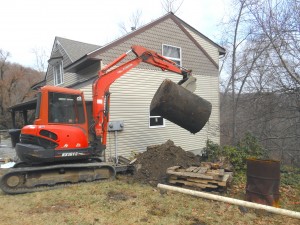 Before commencing excavation, customers are given detailed explanations of our procedures and any environmental implications. We will work with a customer’s insurance company to ensure proper claims reimbursement. Once work has begun, tank owners are kept informed every step of the way. From the first shovel to the final seed, Envirostar handles the entire project. While each project is treated differently, depending on tank and ground conditions, typical removal and replacement involves the following steps:
Before commencing excavation, customers are given detailed explanations of our procedures and any environmental implications. We will work with a customer’s insurance company to ensure proper claims reimbursement. Once work has begun, tank owners are kept informed every step of the way. From the first shovel to the final seed, Envirostar handles the entire project. While each project is treated differently, depending on tank and ground conditions, typical removal and replacement involves the following steps:
- New tank installation: A new fuel tank is installed, and if necessary a temporary fuel tank is installed.
- Excavation: A backhoe is used to expose the tank.
- Sludge removal: Any residue is pumped out.
- Tank removal: The old tank is carefully removed from the ground. When permitted by code, in-ground closure may be used, where the tank is left in place and filled with sand, foam or slurry.
- Inspection: Samples are drawn to determine the nature and extent of contamination.
- Soil removal: If contamination is found, all affected soil is removed.
- Soil disposal: Envirostar’s Class A license with HAZMAT endorsement enables us to truck soil to a burn facility or landfill, conforming to DEC, DEP, and local codes.
- Tank replacement: A new tank is installed in the same location if customer has contracted to have the tank installed in-ground.
- Soil replacement: Clean soil is used to fill the hole.
- Landscaping: Areas are graded, seeded and returned to their original condition.
- Closure Letter: We supply each customer with a letter specifying sample findings and documenting the remediation used.
